Welcome back to Booze News, a blog about the Baltimore City Liquor Board.
Each post of this rebooted version of the blog will focus on a specific example of a liquor licensed establishment from each of the nine Baltimore City police districts. We will compare 311 calls, 911 calls, Liquor Board records, police records, and community testimony.
When a community member calls 311 about a liquor license issue, how long does it take for an inspector to respond? What kind of information is included in a Liquor Board inspection report, and what is left out? How many inspectors work at night? If a police officer makes an arrest on the premises of a liquor licensed establishment, does that report make its way to the Liquor Board for a public hearing? If not, why not?
These are all questions that we will try to answer over the next nine months of posts, roughly one post per month, one per police district.
Let’s begin with the establishment that inspired this Booze News reboot: Waverly Tavern.
According to community members who live nearby, until five years ago or so, Waverly Tavern was a quiet neighborhood tavern, run by a neighborhood resident for members of the community. At some point in the 1950s, the tavern was carved out of a rowhouse at the residential corner of 38th Street and Old York Road in Waverly. In every direction on both Old York and 38th Streets, there are rowhouses, mostly occupied but some vacant.
In the spring of 2018, the Waverly Improvement Association protested the renewal of the Waverly Tavern’s license. Since new management had taken over the establishment several years prior, neighbors complained of daily drug transactions in and around the packaged goods side of the building.
Like many BD-7 taverns, Waverly Tavern is divided into two separate areas: a packaged goods side, where customers are served beverages to go from behind a partition, and a tavern side, where customers can order alcoholic beverages to be consumed on-premises. Often, since the packaged goods side of an establishment is more lucrative, physically safer for their employees, and can be run with fewer staff, BD-7 licensees close off the tavern side of their business, which is illegal under the Alcoholic Beverages Article of the Maryland Code.
The major of the Northern District of the Baltimore Police Department, who was present at the renewal hearing along with two sergeants and several other officers, testified that Old York and 38th Street was the most dangerous intersection in his district, directly due to the presence of Waverly Tavern. The major says that he pays around $60,000 per year for a police officer to sit on the corner of this intersection because of the lack of safety on the corner.
You can watch the protest of renewal hearing here at the link:
At the end of the hearing, the Liquor Board commissioners unanimously voted to renew the license, despite community and police testimony about the life and death dangers emanating from the tavern. The tavern owners essentially said that they were victims of a violent neighborhood and took no responsibility for contributing to or abetting the violence. They told the board, through their attorney, that they could not afford to hire security to make sure that individuals were not committing crimes on their property.
The commissioners said that they could not in good conscience decline to renew the license, because there were no Liquor License-specific 311 complaints on the record. (There were trash-related 311 complaints for this address, but no complaints specifically coded as Liquor License-specific.)
Let’s take a look at the file.
As of February 1, 2019, there were only five inspector’s reports in the file for Waverly Tavern: one from 2016, two from 2014, and two from 2013.
Here they all are, in order: (right click on the image and choose “open in a new tab” to see them in a larger size)
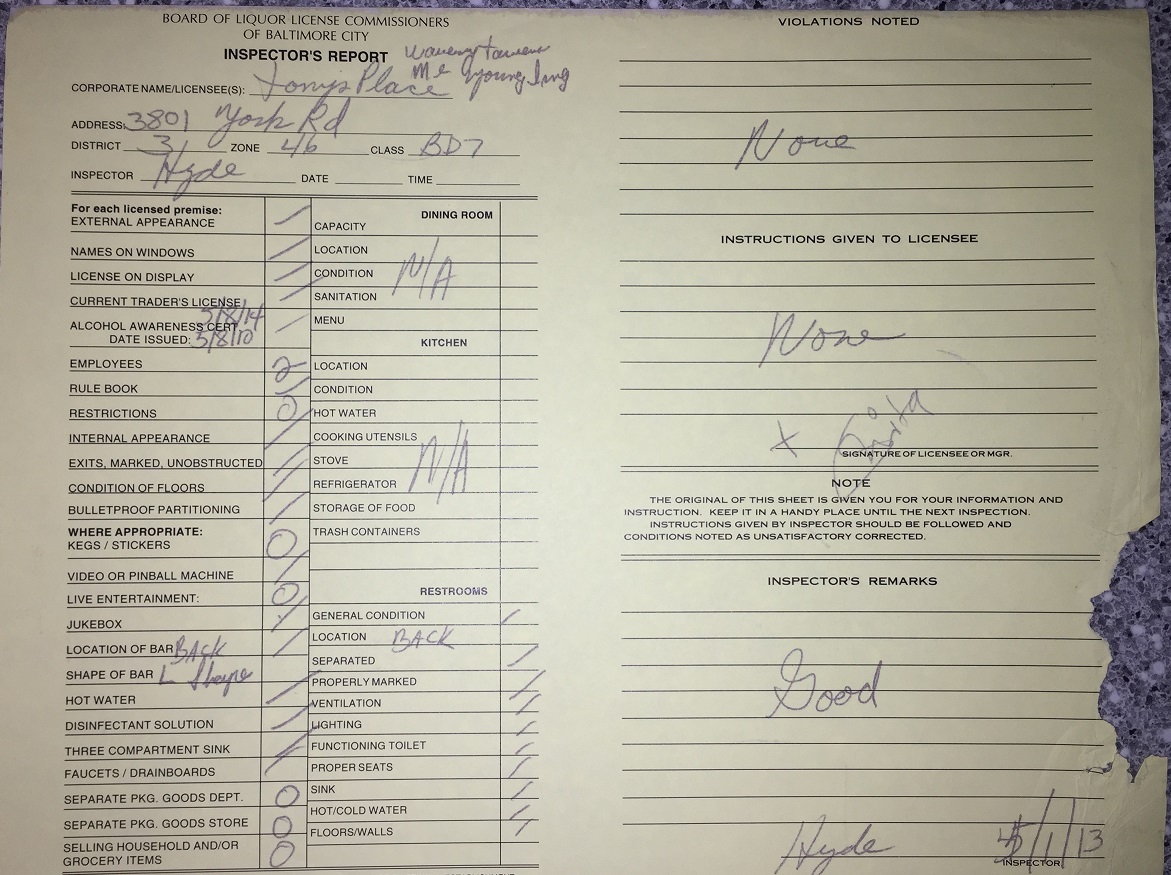
Someone seems to have taken a nibble out of this one.
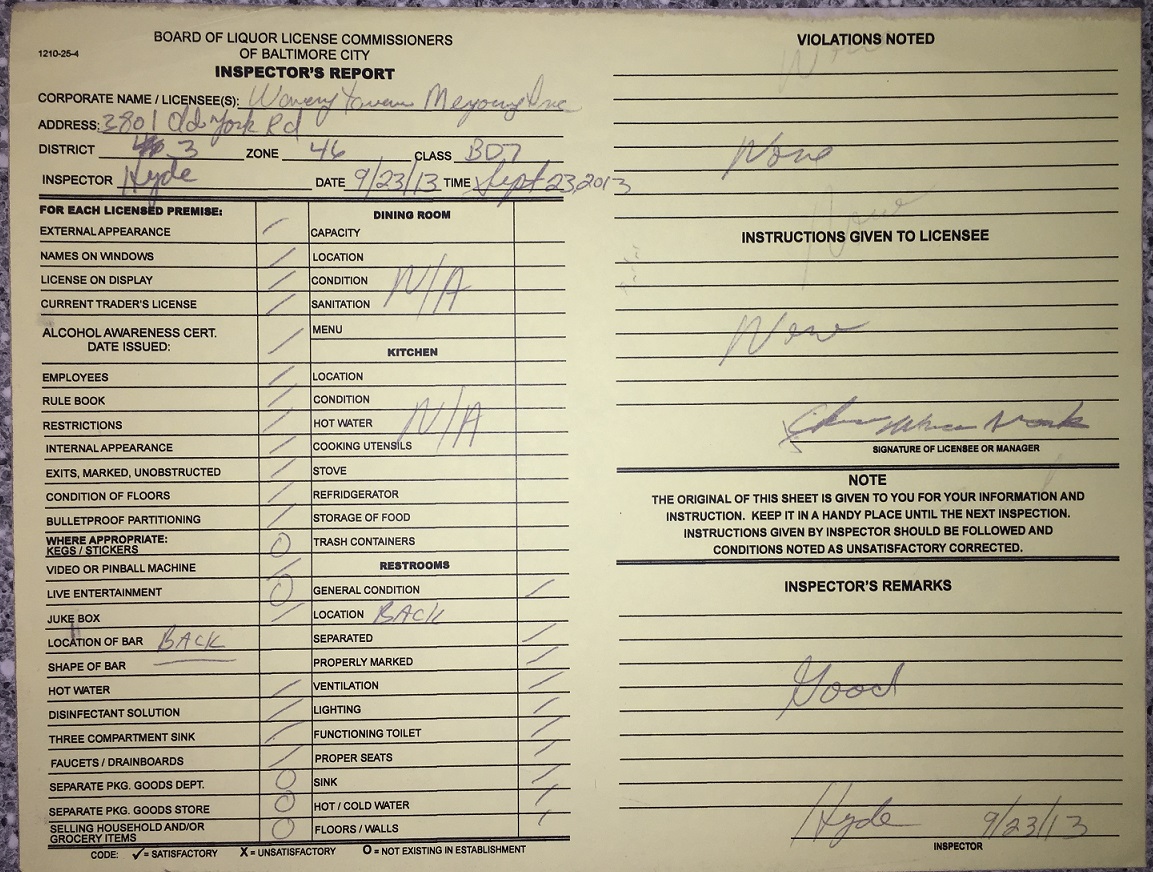
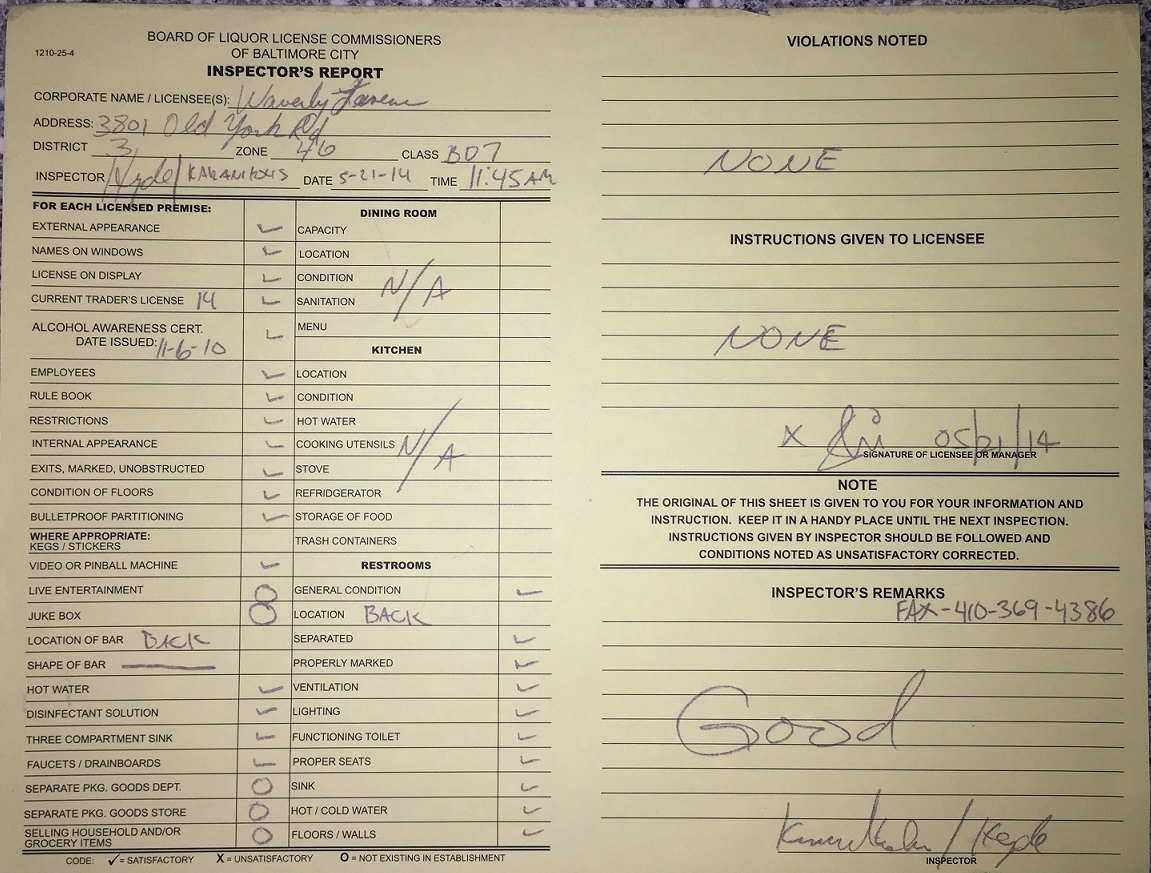
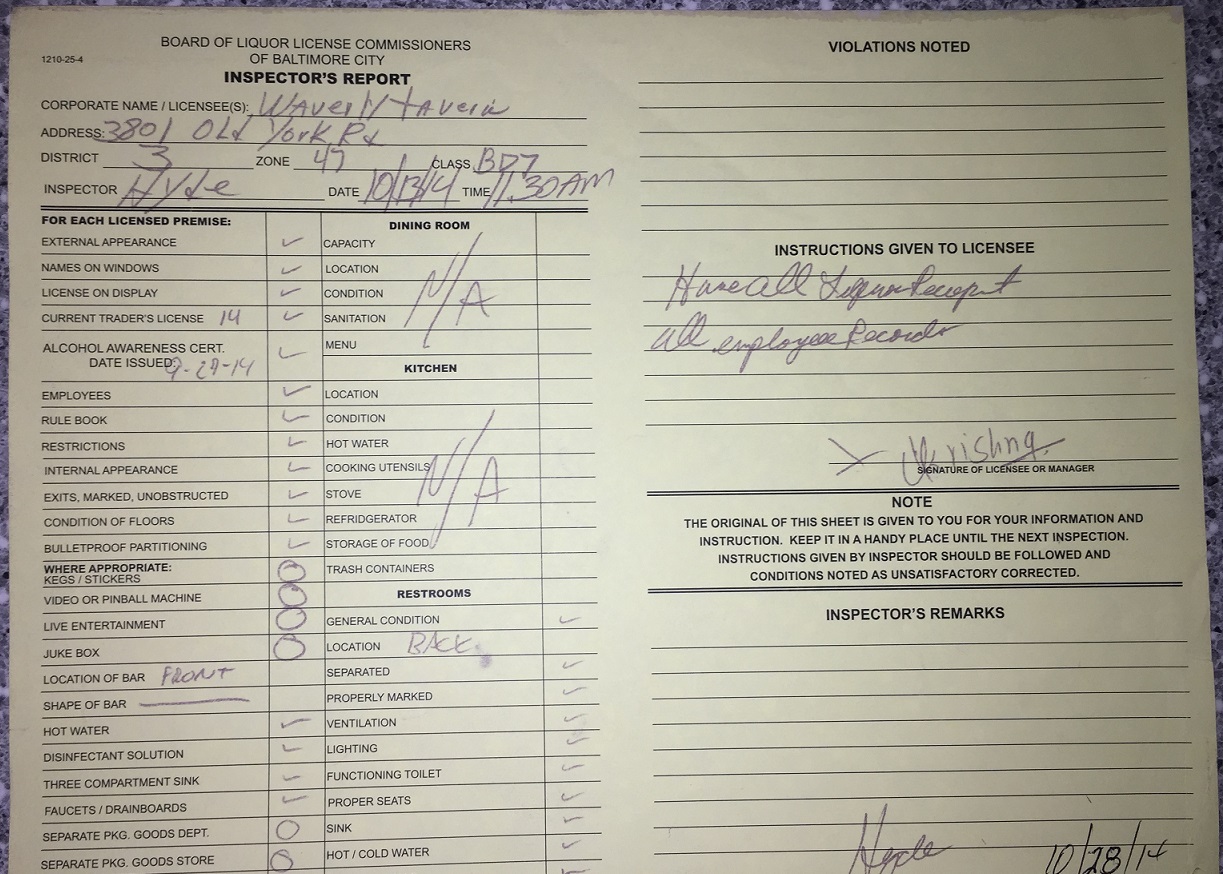
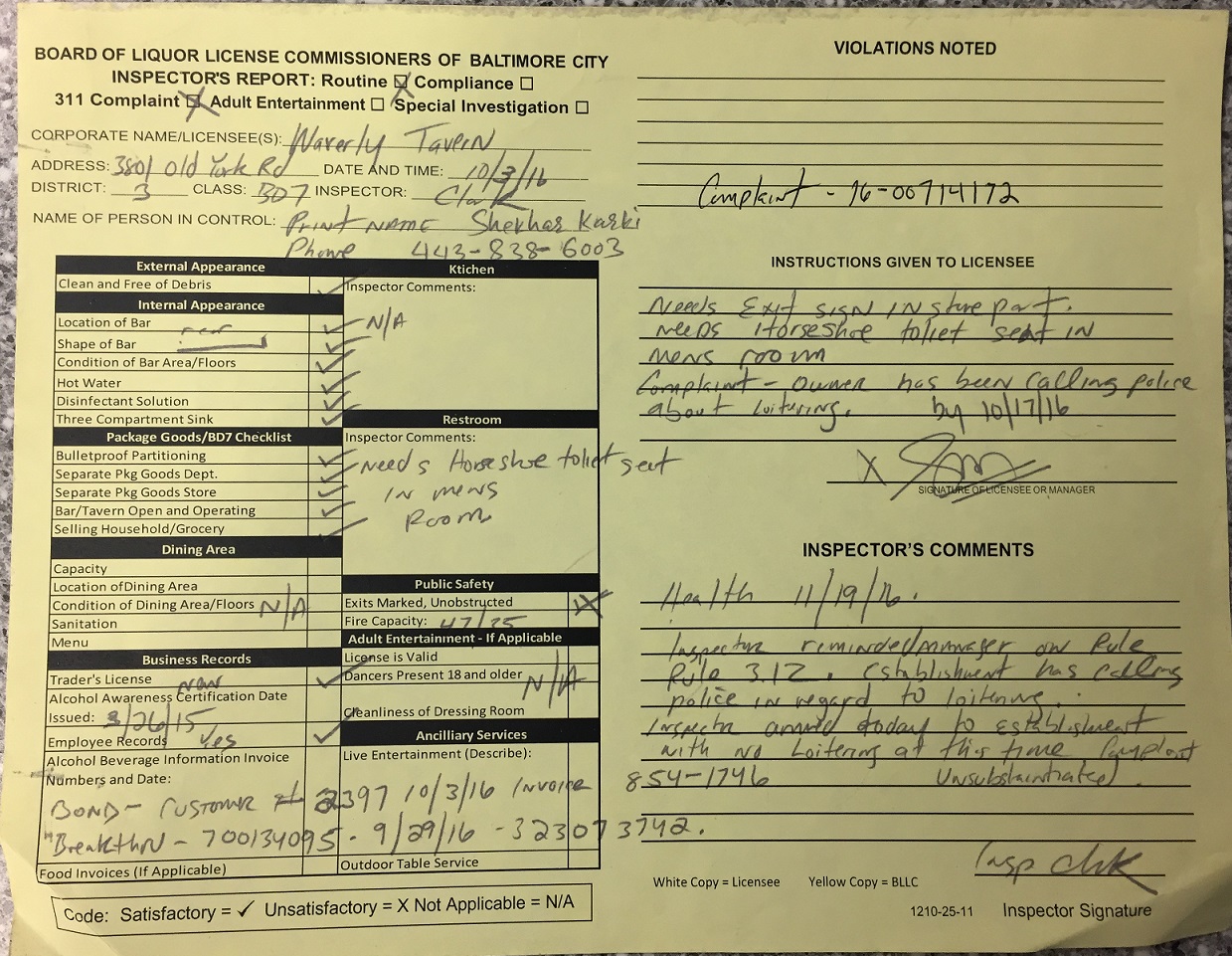
The last report from 2016 contains more information than the first four routine inspection reports. Apparently, there was a 311 complaint for loitering (data about which can no longer be accessed through the city’s revamped 311 system), to which an inspector was responding. The date and time of the original 311 complaint was not provided, and the report does not note the time of day that the inspector visited. There is no followup in the file about the lack of toilet seat or exit sign or other things mentioned in the report.
The Liquor Board has stated that its mission is to inspect each establishment four times per year, so there should be records of four compliance inspections for each year in the file, instead of five total over the past six years.
Looking at the reports, though: should the agency be prioritizing these quarterly reports? What information is being gathered here? The bar shape and location is not particularly likely to migrate around the building, and the fire capacity is not likely to change. Under my previous role as Booze News blogger, I almost never saw a violation hearing come up for anything found in a compliance check; rather, the vast majority of citations given are for sales to minors and BD-7 tavern checks, which are all completed by the Board’s investigative staff.
What are some questions or thoughts that come up as you look at these inspection reports? What kind of data is the Liquor Board collecting, if any? Please leave them in the comments below!
Liquor Board staff says that electronic inspection reports will be added to their Liquor License Online Library beginning March 2019; we will keep you posted on whether they meet that deadline.
In the meantime, the Online Library has been only sporadically updated since it was first created in 2016. The Alcoholic Beverages Reform Act of 2014 required that the agency create an online accessible database by October 1, 2015. The Board finally did create the database and made it available to the public on August 1, 2016, ten months past the statutory deadline.
The database contains documents from 2013-2015 but mostly seems not to have been updated since then, making it basically unusable for communities who seek recent data for hearing preparation. And, as we can see from the Waverly Tavern example, even if community members go to the Liquor Board’s offices to look through the paper file, generally, recent inspection reports are unavailable there, either.
Scans of the license itself and the annual renewal applications have been updated, but there is no other information online about inspections, community complaints, or anything else that could be useful to a community member who is concerned about a specific establishment.
We’ll leave it there for now, having delved into a few of the issues that communities run into when trying to get information from the Liquor Board. Let us know what you think about this new Booze News endeavor! Are there specific establishments that you would like to know more about in your neighborhood? Leave a comment below.